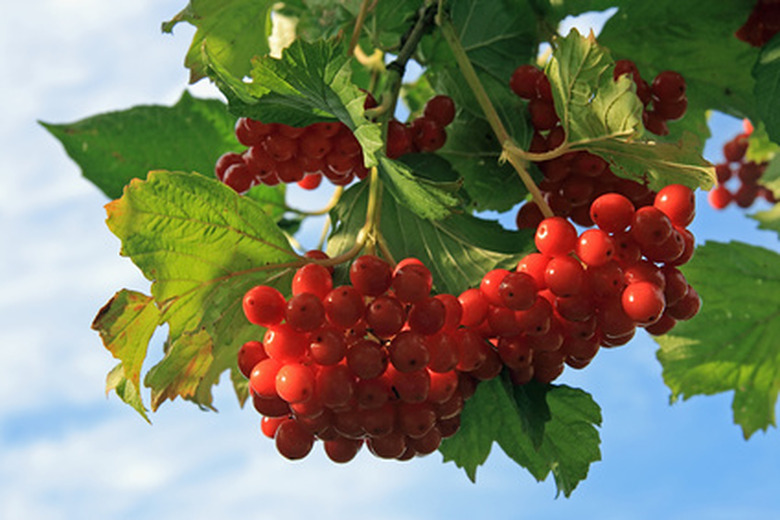Highbush Cranberry Diseases
Not producing the edible cranberries associated with Thanksgiving, the highbush cranberry (Viburnum opulus var. americanum) does produce attractive clusters of tiny berries worthwhile for an autumn-themed landscape. Best grown in U.S. Department of Agriculture Plant Hardiness Zones 3 through 7, this North American deciduous shrub is generally disease and pest free. Many compact varieties exist today, affording gardeners wide choices for mature shrub sizes or fruit colors. The former botanical name for this plant is Viburnum trilobum.
Bacterial Leaf Spot
Michael Dirr, author of "Viburnums," notes that bacterial leaf spot occasionally inflicts visual black spots on the oldest of shrub leaves. Tolerate the minimal leaf drop that occurs in late summer before the leaves turn color and drop away in autumn.
- Not producing the edible cranberries associated with Thanksgiving, the highbush cranberry (Viburnum opulus var.
- Michael Dirr, author of "Viburnums," notes that bacterial leaf spot occasionally inflicts visual black spots on the oldest of shrub leaves.
Botryosphaeria Canker
Highbush cranberry appreciates moist to even soggy soil conditions. If suffering under prolonged drought conditions, the shrub may lose foliage on branches infested with Botryospaeria canker. Leaves first wilt and drop away and the branches become laced with a brown to black pimple-like fungal fruiting bodies. The underbark of branches turns dark brown. The worst-case scenario is these leaves prematurely drop off. Prune away diseased branches and water sick plants.
Downy Mildew
Overly wet spring weather can lead to downy mildew on foliage caused by the fungus Plasmopara viburni. Angled spots that are confined by the leaf veins develop into blotches that wilt and die. Severely harmed leaves physically drop-off. A light-colored downy mildew sparsely cloaks the spots on leaf undersides. Avoid wetting foliage in springtime with overhead irrigation and rake up fallen leaves each autumn and destory them–do not compost these fungus-infected leaves.
- Highbush cranberry appreciates moist to even soggy soil conditions.
- If suffering under prolonged drought conditions, the shrub may lose foliage on branches infested with Botryospaeria canker.
Powdery Mildew
Little damage results from the presence of powdery mildew on highbush cranberry leaves, although the white fungal growth may look rather shocking. Michael Dirr recommends simply tolerating powdery mildew if it does rear itself since it doesn't really hurt the plant.
Occasional Disease Concerns
Even though highbush cranberry grows without much risk of disease problems, regional soils or other factors may find plants inflicted with diseases other than the four aforementioned. Other possible diseases on this shrub include crown gall, rust, spot anthracnose and verticillium wilt. If you cannot indentify the disease problem, take a sample of the affected leaf or branch to your local cooperative extension office or plant disease professional for help.
References
- "Viburnums"; Michael A. Dirr; 2007
- U.S. Department of Agriculture: Highbush Cranberry
